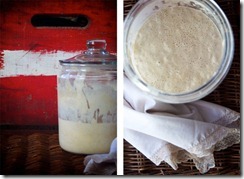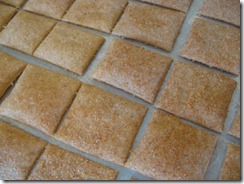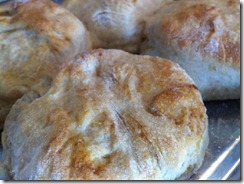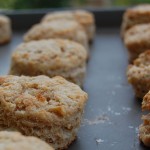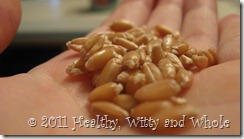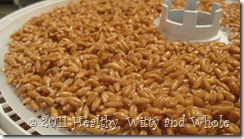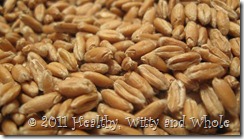I’ve had a love/hate relationship with sourdough bread. Back when I first began trying to make it 3 or 4 years ago, I never mastered it and it ended up being more hassle than it was worth. Last year, I tried making my own sourdough starter out of rye flour. It turned out great and I spent the next few months making all sorts of yummy sourdough breads, but still really couldn’t get the bread loaf down. My family went on a grain-free diet for awhile, so my sourdough starter was ruined.
A few weeks ago, I decided to try again. I started my sourdough from rye flour. Many instructions will tell you wheat or rye is fine, but I’ve found that rye is the easiest to get started. It bubbles up and ferments properly without a lot of worry. After about a week, when my culture was ready, I made some no-knead sourdough bread. I made two different recipes. One was a complete flop which some member of my family said needed cutting with a chainsaw. :-) The second turned out beautifully. Since then, I’ve made sourdough biscuits and crackers. Tonight, I have some sourdough rolls mixed up ready for finishing up in the morning for our midday meal.
I’ve made bread since I was nine years old, so I was already aware that bread making is an art and a skill. If you add sprouting grain and soaking flour to your bread making regime, then it is a new art form and skill that takes developing. Sourdough is the same way. It takes learning what the dough needs to feel like, how to handle it, what to add.
I’m slowly gaining new knowledge in the area of sourdough. Eventually, I hope to have some new recipes of my own to share. For now, I’m going to share a few I’ve made and we’ve enjoyed.
Sourdough Starter instructions:
I found Jenny, from Nourished Kitchen, to have the best instructions on sourdough starting. If you follow her instructions, using rye flour (or wheat if you don’t have access to rye), then you will be on your way to making wonderful sourdough products. Once the sourdough is ready to bake with, I switched to wheat flour. If I want to bake a big batch of something, I’ll feed it a cup of flour and 2/3 cup water for a couple days and then bake with it. Stirring vigorously is very key to the success of the starter. I found that stirring it for about a minute rapidly will make it nice and bubbly and foam up like a proper, active starter should.
Sourdough Baked Goods:
Sourdough Crackers are probably our favorite baked item I’ve made with my starter. These crackers are super easy and delightfully crunchy. Don’t roll them very thin, because if you leave them slightly thicker than you would normally do for crackers, they will puff up and be beautiful, crunchy and delicious.
Sourdough No-Knead Bread is a very delicious, easy bread. It rises beautifully. I made mine with Kamut flour, but I think I’ll try Spelt next time. It has a very crunchy, artisan crust.
One of my personal favorites is Sourdough Biscuits. I tried this recipe last year. They are super easy to make and delightfully sourdoughy good. :-)
Do you have any sourdough stories? What are your favorite recipes? What are some recipes that you would like to see me make and share from my sourdough starter?
